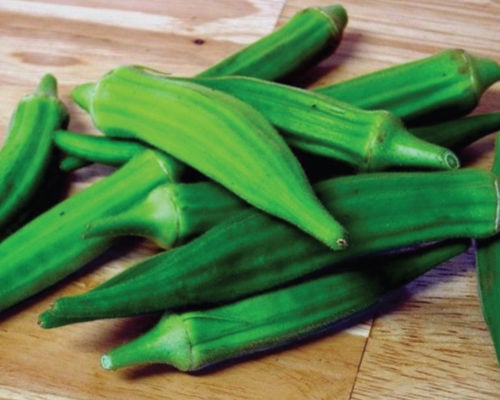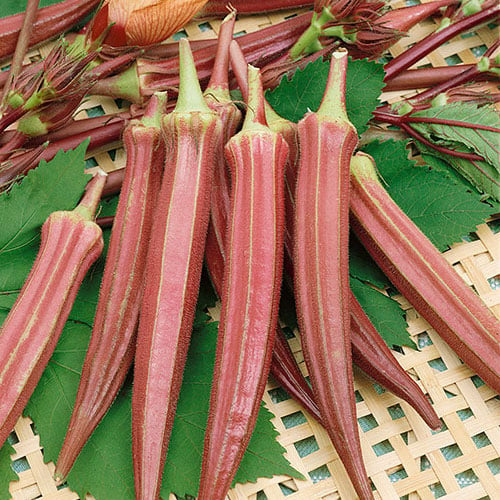
Learning Download: How to Grow Okra
From Seed to Harvest: A guide to growing okra.
Okra may not be a common vegetable found in a garden, but it makes for good canning and pickling. It also can be used in stews. Okra is a warm-weather plant often grown in southern climates. It has a taste similar to eggplant.
To plant:
Soak the okra in water for 12 to 18 hours prior to planting to soften the outer shell of the seed. Plant okra in the spring or early summer after the danger of frost has passed. In northern climates, plant okra indoors four to six weeks prior to the last frost date. Since okra can reach 6 feet tall, plant it in an area of the garden where its shade won’t harm other plants’ growth. Plant the seeds 1 inch deep in rows 3 feet apart in an area that receives full sun.
To grow:
Once seedlings appear, thin them to 12-18 inches apart. Water 1 inch per week and mulch to prevent weeds. Okra does best in soil with a pH of 5.8 to 6.8.
To harvest:
Okra plants can produce crop for 10 to 12 weeks. Okra is ready two months after planting. Pods should be approximately 3 inches long when harvested. The larger they grow, the tougher the pods become so harvest regularly. Wear gloves while harvesting because okra has spines.
What okra craves:
Prior to planting, mix a 10-10-10 fertilizer in with the soil. Once okra reaches 6 inches tall, give a side-dressing of fertilizer. Side-dress again two to three weeks later. Reapply the fertilizer every four to six weeks throughout its growing season.
Chicken manure can be used instead of a chemical fertilizer, as it is high in potassium and phosphorous.
Where to buy okra seeds:
You can find different types of okra seeds, ranging in colors as well as spineless options at Urban Farmer.
Learning Download: Common pests and diseases: Okra
Common pests and diseases: Okra
When growing vegetables, it is always exciting to care for the plant throughout its growing phase and then harvest it for delicious recipes later on, but one thing to watch out for is pests and diseases. Different plants are susceptible to different types of pests and diseases, and it is important to make yourself aware so you can keep a watchful eye and also take any preventative methods to keep your plants safe throughout their lifespan.
Okra can fall victim to several pests and diseases.
Pests:
Insects affecting okra plants include armyworms, corn earworms, cucumber beetles, cabbage loopers and more.
Armyworms will cause closely grouped and irregular holes in the leaves of the okra plant. They feed heavily as larvae and cause skeleontized leaves. Shallow wounds also can appear on the fruit. To organically control this issue, apply Bacillus thuringiensis.
Corn earworms will cause damage to the leaves, buds, flowers and pods of the okra plant. This insect can overwinter in the soil. Monitor the plants for signs or larvae or eggs, and apply Bacillus thuringiensis if you notice an infestation. You can also apply Entrust SC.
Cucumber beetles are spotted yellow beetles that cause stunted seedlings and damaged leaves, as well as plants exhibiting signs of bacterial wilt and will scar the okra. These beetles will overwinter in the soil. To prevent them, use floating row covers, apply kaolin clay and if necessary, use an insecticide.
Cabbage loopers will create holes in the leaves that can vary in size, and the caterpillars are pale green with white lines. Hand pick the loopers from the plants or apply Bacillus thuringiensis to kill the younger larvae.
Diseases:
Some of the common diseases affecting okra plants include charcoal rot, fusarium wilt, powdery mildew, southern blight and more.
Charcoal rot will cause discoloration in the stem at the soil line, and it also can create cankers on the stem. Leaves can wilt or fall from the plant. To prevent this disease, practice crop rotation and avoid water stress by utilizing proper irrigation.
Fusarium wilt will cause seedling leaves to wilt and older plants can also show wilting or leaf chlorosis. Wilting will be gradual. The disease prefers warm temperatures. To prevent this, use disease-free seed, plant resistant varieties and fumigate the soil.
Powdery mildew will appear as a powdery white covering on the leaves, and the patches may then cover the entire plant. Leaves may roll upward. Use overhead irrigation to wash the fungus off the plant, and plant the okra as early in the season as possible.
Southern blight will cause leaves to suddenly wilt, foliage will yellow and the stem will turn brown. This fungus prefers high temperatures and high humidity, making it more common in subtropical regions. If this disease occurs, remove all infected plants. To prevent the disease, don’t overcrowd plants, rotate crops and wrap the lower part of the stems with aluminum foil.


